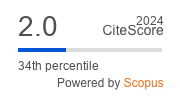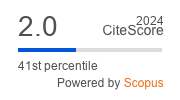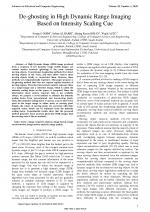| 3/2020 - 1 | View TOC | « Previous Article | Next Article » |
De-ghosting in High Dynamic Range Imaging Based on Intensity Scaling CueSHIM, S.-O |
| Extra paper information in |
| Click to see author's profile in |
| Download PDF |
Author keywords
image sequence analysis, image fusion, image reconstruction, image motion analysis, image quality
References keywords
dynamic(26), range(20), high(18), image(17), images(15), comput(13), imaging(12), tone(10), process(10), pattern(9)
Blue keywords are present in both the references section and the paper title.
About this article
Date of Publication: 2020-08-31
Volume 20, Issue 3, Year 2020, On page(s): 3 - 10
ISSN: 1582-7445, e-ISSN: 1844-7600
Digital Object Identifier: 10.4316/AECE.2020.03001
Web of Science Accession Number: 000564453800001
SCOPUS ID: 85090343221
Abstract
A High Dynamic Range (HDR) image produced from a sequence of low dynamic range (LDR) images can contain motion artefacts (ghosting) if the scene contains moving objects. Conventional de-ghosting methods first detect moving objects in the scene, and then either remove those moving objects totally or reconstruct them. However, these methods are computationally expensive. This paper proposes a de-ghosting method that does not require explicit detection of moving regions. First, the ratio between camera exposure times of a target image and a reference image, which is called the intensity scaling factor in this paper, is computed. Since the information about camera exposure time is not available always, we propose a novel method to estimate the intensity scaling factor from non-saturated and non-moving pixels. Then, the estimated scaling factor is used as a cue to label every pixel in the target image as either static or moving pixel. Finally, the values of moving pixels are corrected with their expected values which can be estimated from the intensity scaling factor. Experimental results show that the proposed method generates more accurate ghost-free HDR images than the existing state of the art methods. |
| References | | | Cited By «-- Click to see who has cited this paper |
| [1] F. Banterle, A. Artusi, K. Debattista, A. Chalmers, Advanced High Dynamic Range Imaging: Theory and Practice. Boca Raton, FL, USA: CRC Press, 2017. [CrossRef] [SCOPUS Times Cited 252] [2] S. K. Nayar, T. Mitsunaga, "High dynamic range imaging: Spatially varying pixel exposures," in Proc. IEEE Conf. Comput. Vis. Pattern Recognit., pp. 472-479, June 2000. [CrossRef] [SCOPUS Times Cited 517] [3] M. A. Robertson, S. Borman, R. L. Stevenson, "Estimation-theoretic approach to dynamic range enhancement using multiple exposures," J. Electron. Imaging, vol. 12, no. 2, pp. 219-229, April 2003. [CrossRef] [Web of Science Times Cited 158] [SCOPUS Times Cited 206] [4] Z. Li and J. Zheng, "Visual-salience-based tone mapping for high dynamic range images," IEEE Trans. Ind. Electron., vol. 61, no. 12, pp. 7076-7082, March 2014. [CrossRef] [Web of Science Times Cited 62] [SCOPUS Times Cited 72] [5] B. K. Kim, R. H. Park, S. Chang, "Tone mapping with contrast preservation and lightness correction in high dynamic range imaging," Signal, Image and Video Processing, vol. 10, no. 8, pp. 1425-1432, July 2016. [CrossRef] [Web of Science Times Cited 17] [SCOPUS Times Cited 18] [6] S. Ferradans, M. Bertalmio, E. Provenzi, V. Caselles, "An analysis of visual adaptation and contrast perception for tone mapping," IEEE Trans. Pattern Anal. Mach. Intell., vol. 33, no. 10, pp. 2002-2012, March 2011. [CrossRef] [Web of Science Times Cited 86] [SCOPUS Times Cited 97] [7] K. Kim, J. Bae, J. Kim, "Natural HDR image tone mapping based on retinex", IEEE Trans. Consum. Electron., vol. 57, no. 4, pp. 1807-1814, November 2011. [CrossRef] [Web of Science Times Cited 48] [SCOPUS Times Cited 62] [8] I. R. Khan, S. Rahardja, M. M. Khan, M. M. Movania, F. Abed, "A tone-mapping technique based on histogram using a sensitivity model of the human visual system," IEEE Trans. Ind. Electron., vol. 65, no. 4, pp. 3469-3479, October 2017. [CrossRef] [Web of Science Times Cited 79] [SCOPUS Times Cited 93] [9] C. Jung, T. Sun, "Optimized perceptual tone mapping for contrast enhancement of images," IEEE Trans. Circuits Syst. Video Technol., vol. 27, no. 6, pp.1161-1170, February 2016. [CrossRef] [Web of Science Times Cited 27] [SCOPUS Times Cited 33] [10] G. Eilertsen, R. K. Mantiuk, and J. Unger, "A comparative review of toneâmapping algorithms for high dynamic range video," Comput. Graph. Forum, vol. 36, no. 2, pp. 565-592, May 2017. [CrossRef] [Web of Science Times Cited 71] [SCOPUS Times Cited 83] [11] G. Yue, C. Hou, K. Gu, S. Mao, W. Xhang, "Biologically inspired blind quality assessment of tone-mapped images," IEEE Trans. Ind. Electron., vol. 65, no. 3, pp.2525-2536, March 2018. [CrossRef] [Web of Science Times Cited 58] [SCOPUS Times Cited 66] [12] G. Yue, C. Hou, T. Zhou, "Blind quality assessment of tone-mapped images considering colorfulness, naturalness and structure," IEEE Trans. Ind. Electron., vol. 66 no. 5, pp. 3784-3793, July 2018. [CrossRef] [Web of Science Times Cited 58] [SCOPUS Times Cited 62] [13] H. Yeganeh, Z. Wang, "Objective Quality Assessment of Tone-Mapped Images," IEEE Trans. Image Process., vol. 22, no. 2, pp. 657-667, February 2013. [CrossRef] [Web of Science Times Cited 470] [SCOPUS Times Cited 553] [14] E. A. Khan, A. O. Akyuz, E. Reinhard, "Ghost Removal in High Dynamic Range Images," in Proc. IEEE Int. Conf. Image Process., pp. 2005-2008, October 2006. [CrossRef] [Web of Science Times Cited 147] [SCOPUS Times Cited 200] [15] O. T. Tursun, A. O. Akyuz, A. Erdem, E. Erdem, "The state of the art in HDR deghosting: a survey and evaluation," Comput. Graph. Forum, vol. 34, no. 2, pp. 683-707, June 2015. [CrossRef] [Web of Science Times Cited 84] [SCOPUS Times Cited 106] [16] M. Granados, H. P. Seidel, H. Lensch, "Background estimation from non-time sequence images," in Proc. Graphics & Interface, Canadian Information Processing Society, pp. 33-40, May 2008. [17] A. Srikantha, D. Sidibe, "Ghost detection and removal for high dynamic range images: Recent advances," Signal Process Image., vol. 27, no. 6, pp. 650-662, July 2012, [CrossRef] [Web of Science Times Cited 84] [SCOPUS Times Cited 106] [18] S. Silk, J. Lang, "Fast high dynamic range image deghosting for arbitrary scene motion," in Proc. Graphics & Interface, Canadian Information Processing Society, pp. 85-92, May 2012. [19] W. Zhang, W. K. Cham, "Gradient-directed composition of multi-exposure images," in Proc. IEEE Conf. Comput. Vis. Pattern Recognit., pp. 530-536, June 2010. [CrossRef] [Web of Science Times Cited 69] [SCOPUS Times Cited 85] [20] F. Pece, J. Kautz, "Bitmap movement detection: HDR for dynamic scenes," in IEEE Conf. Visual Media Production, pp. 1-8, November 2010. [CrossRef] [SCOPUS Times Cited 105] [21] O. Galo, N. Gelfandz, W. C. Chen, M. Tico, K. Pulli, "Artifact-free high dynamic range imaging," in IEEE Int. Conf. Computational Photography, pp. 1-7, April 2009. [CrossRef] [SCOPUS Times Cited 210] [22] K. Jacobs, C. Loscos, G. Ward, "Automatic high-dynamic range image generation for dynamic scenes," IEEE Comput. Graph., vol. 28, no. 2, pp. 84-93, March 2008. [CrossRef] [Web of Science Times Cited 171] [SCOPUS Times Cited 219] [23] H. Y. Lin, W. Z. Chang, "High dynamic range imaging for stereoscopic scene representation," in Proc. IEEE Int. Conf. Image Process., pp. 4305-4308, November 2009. [CrossRef] [SCOPUS Times Cited 45] [24] D. K. Lee, R. H. Park, S. Chang, "Improved histogram based ghost removal in exposure fusion for high dynamic range images," in Proc. IEEE Int. Symposium Consum. Electron., pp. 586-591, June 2011. [CrossRef] [SCOPUS Times Cited 7] [25] T. H. Min, R. H. Park, S. Chang, "Histogram based ghost removal in high dynamic range images," in Proc. IEEE Int. Conf. Multimedia and Expo, pp. 530-533, July 2009. [CrossRef] [SCOPUS Times Cited 38] [26] S. Wu, S. Xie, S. Rahardja, Z. Li, "A robust and fast anti-ghosting algorithm for high dynamic range imaging," in Proc. IEEE Int. Conf. Image Process., 2010, pp. 397-400, September 2010. [CrossRef] [SCOPUS Times Cited 34] [27] W. Zhang, W. K. Cham, "Reference-guided exposure fusion in dynamic scenes," J. Vis. Commun. Image. R., vol. 23, no. 3, pp. 467-475, April 2012. [CrossRef] [Web of Science Times Cited 46] [SCOPUS Times Cited 57] [28] T. H. Oh, J. Y. Lee, I. S. Kweon, "High dynamic range imaging by a rank-1 constraint," in Proc. IEEE Int. Conf. Image Process., pp. 790-794, September 2013. [CrossRef] [SCOPUS Times Cited 24] [29] M. Granados, K. I. Kim, J. Tompkin, C. Theobalt, "Automatic noise modeling for ghost-free HDR reconstruction," ACM Trans. Graphics, vol. 32, no. 6, p. 201, November 2013. [CrossRef] [Web of Science Times Cited 53] [SCOPUS Times Cited 65] [30] C. Wang, C. Tu, "An exposure fusion approach without ghost for dynamic scenes," in Proc. IEEE Int. Congress Image and Signal Processing, vol. 2, pp. 904-909, December 2013. [CrossRef] [SCOPUS Times Cited 10] [31] K. R. Prabhakar, R. Arora, A. Swaminathan, K. P. Singh, R. V. Babu, "A fast, scalable, and reliable deghosting method for extreme exposure fusion," in IEEE Int. Conf. Computational Photography, pp. 1-8, May 2019. [CrossRef] [Web of Science Times Cited 18] [SCOPUS Times Cited 60] [32] S. O. Shim, I. R. Khan, "Removal of ghosting artefacts in HDRI using intensity scaling cue," in SIGGRAPH Asia 2017 Technical Briefs, p. 16, November 2017. [CrossRef] [Web of Science Times Cited 3] [SCOPUS Times Cited 5] [33] Q. Yan, D. Gong, P. Zhang, Q. Shi, J. Sun, I. Reid, Y. Zhang, "Multi-Scale Dense Networks for Deep High Dynamic Range Imaging," in Proc. IEEE Winter Conf. Appl. Comput. Vis. (WACV), pp. 41-50, January 2019. [CrossRef] [Web of Science Times Cited 68] [SCOPUS Times Cited 76] [34] L. Bogoni, "Extending dynamic range of monochrome and color images through fusion," in Proc. IEEE Int. Conf. Pattern Recognit., vol. 3, pp. 7-12, September 2000. [CrossRef] [35] H. Zimmer, A. Bruhn, J. Weickert, "Freehand HDR imaging of moving scenes with simultaneous resolution enhancement," Comput. Graph. Forum, vol. 30, no. 2, pp. 405-414, April 2011. [CrossRef] [Web of Science Times Cited 153] [SCOPUS Times Cited 175] [36] T. Jinno, M. Okuda, "Multiple exposure fusion for high dynamic range image acquisition," IEEE Trans. Image Process., vol. 21, no. 1, pp. 358-365, June 2011. [CrossRef] [Web of Science Times Cited 71] [SCOPUS Times Cited 87] [37] S. Ferradans, M. Bertalmio, E. Provenzi, V. Caselles, "Generation of HDR images in non-static conditions based on gradient fusion," in VISAPP, pp. 31-37, February 2012. [CrossRef] [38] D. Hafner, O. Demetz, J. Weickert, "Simultaneous HDR and optic flow computation," in Proc. IEEE Int. Conf. Pattern Recognit., pp. 2065-2070, August 2014. [CrossRef] [Web of Science Times Cited 28] [SCOPUS Times Cited 33] [39] S. Wu, J. Xu, Y. W. Tai, C. K. Tang, "Deep high dynamic range imaging with large foreground motions," in Proc. European Conf. Comput. Vis., pp. 117-132, September 2018. [CrossRef] [Web of Science Times Cited 202] [SCOPUS Times Cited 70] [40] S. C. Park, H. H. Oh, J. H. Kwon, S. D. Lee, "Motion artifact-free HDR imaging under dynamic environments," in Proc. IEEE Int. Conf. Image Process., 2011, pp. 353-356, September 2011. [CrossRef] [SCOPUS Times Cited 9] [41] J. Hu, O. Gallo, K. Pulli, "Exposure stacks of live scenes with hand-held cameras," in Proc. European Conf. Comput. Vis., pp. 499-512, October 2012. [CrossRef] [SCOPUS Times Cited 55] [42] P. Sen, N. K. Kalantari, M. Yaesoubi, S. Darabi, D. B. Goldman, E. Shechtman, "Robust patch-based HDR reconstruction of dynamic scenes," ACM Trans. Graph., vol. 31, no. 6, pp. 203-1, November 2012. [CrossRef] [Web of Science Times Cited 293] [SCOPUS Times Cited 382] [43] J. Hu, O. Gallo, K. Pulli, X. Sun, "HDR deghosting: How to deal with saturation," in Proc. IEEE Conf. Comput. Vis. Pattern Recognit., pp. 1163-1170, June 2013. [CrossRef] [Web of Science Times Cited 203] [SCOPUS Times Cited 255] [44] H. Farid, "Blind Inverse Gamma Correction," IEEE Trans. Image Process., vol. 10, no. 10, pp. 1428-1433, October 2001. [CrossRef] [Web of Science Times Cited 231] [SCOPUS Times Cited 299] [45] T. Mitsunaga, S. K. Nayar, "Radiometric Self Calibration," in Proc. IEEE Conf. Comput. Vis. Pattern Recognit., vol. 1, pp. 374-380, June 1999. [CrossRef] [46] M. D. Grossberg, S. K. Nayar, "Determining the Camera Response from Images: What is Knowable?" IEEE Trans. Pattern Anal. Mach. Intell., vol. 25, no. 11, pp. 1455-1467, October 2003. [CrossRef] [Web of Science Times Cited 231] [SCOPUS Times Cited 292] [47] M. D. Grossberg, S. K. Nayar, "What is the Space of Camera Response Functions," in Proc. IEEE Conf. Comput. Vis. Pattern Recognit., vol. 2, pp. II-602, June 2003. [CrossRef] [48] O. T. Tursun, A. O. Akyuz, A. Erdem, E. Erdem, "An objective deghosting quality metric for HDR images," Comput. Graph. Forum, vol. 35, no. 2, pp. 139-152, May 2016. [CrossRef] [Web of Science Times Cited 70] [SCOPUS Times Cited 79] [49] Y. Fang, H. Zhu, K. Ma, Z. Wang, "Perceptual quality assessment of HDR deghosting algorithms," in Proc. IEEE Int. Conf. Image Process., pp. 3165-3169, September 2017. [CrossRef] [SCOPUS Times Cited 9] Web of Science® Citations for all references: 3,359 TCR SCOPUS® Citations for all references: 5,311 TCR Web of Science® Average Citations per reference: 67 ACR SCOPUS® Average Citations per reference: 106 ACR TCR = Total Citations for References / ACR = Average Citations per Reference We introduced in 2010 - for the first time in scientific publishing, the term "References Weight", as a quantitative indication of the quality ... Read more Citations for references updated on 2025-06-05 00:58 in 314 seconds. Note1: Web of Science® is a registered trademark of Clarivate Analytics. Note2: SCOPUS® is a registered trademark of Elsevier B.V. Disclaimer: All queries to the respective databases were made by using the DOI record of every reference (where available). Due to technical problems beyond our control, the information is not always accurate. Please use the CrossRef link to visit the respective publisher site. |
Faculty of Electrical Engineering and Computer Science
Stefan cel Mare University of Suceava, Romania
All rights reserved: Advances in Electrical and Computer Engineering is a registered trademark of the Stefan cel Mare University of Suceava. No part of this publication may be reproduced, stored in a retrieval system, photocopied, recorded or archived, without the written permission from the Editor. When authors submit their papers for publication, they agree that the copyright for their article be transferred to the Faculty of Electrical Engineering and Computer Science, Stefan cel Mare University of Suceava, Romania, if and only if the articles are accepted for publication. The copyright covers the exclusive rights to reproduce and distribute the article, including reprints and translations.
Permission for other use: The copyright owner's consent does not extend to copying for general distribution, for promotion, for creating new works, or for resale. Specific written permission must be obtained from the Editor for such copying. Direct linking to files hosted on this website is strictly prohibited.
Disclaimer: Whilst every effort is made by the publishers and editorial board to see that no inaccurate or misleading data, opinions or statements appear in this journal, they wish to make it clear that all information and opinions formulated in the articles, as well as linguistic accuracy, are the sole responsibility of the author.



